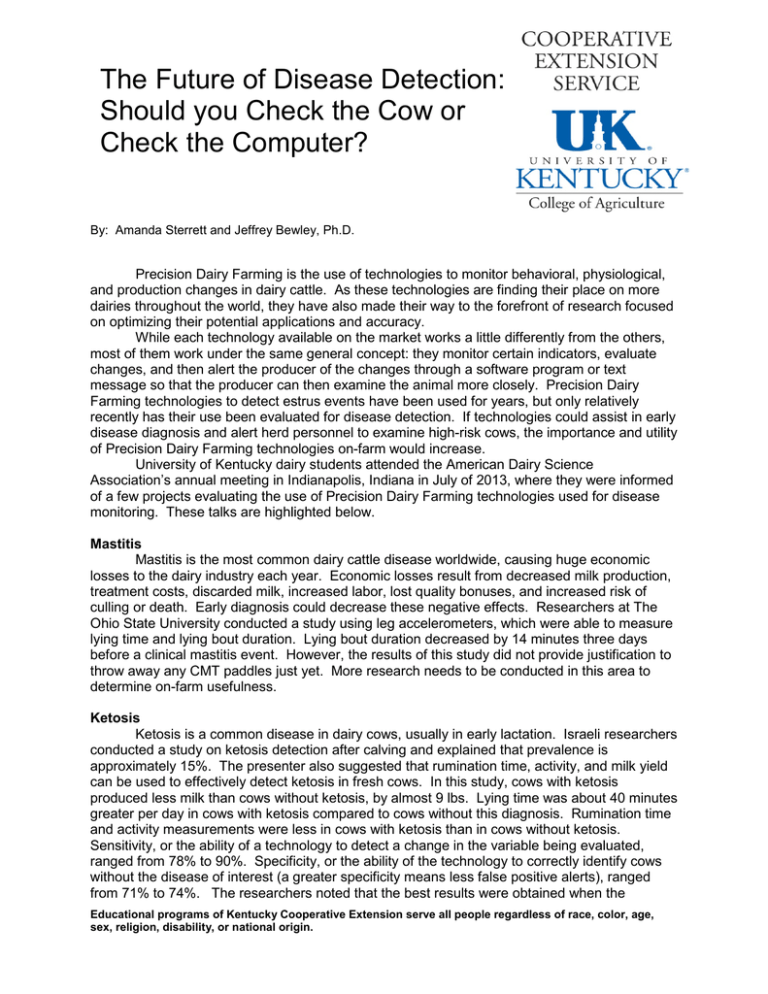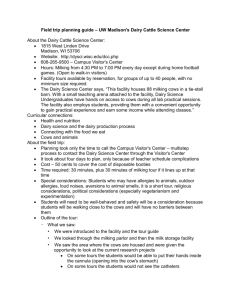The Future of Disease Detection: Should you Check the Cow or
advertisement

The Future of Disease Detection: Should you Check the Cow or Check the Computer? By: Amanda Sterrett and Jeffrey Bewley, Ph.D. Precision Dairy Farming is the use of technologies to monitor behavioral, physiological, and production changes in dairy cattle. As these technologies are finding their place on more dairies throughout the world, they have also made their way to the forefront of research focused on optimizing their potential applications and accuracy. While each technology available on the market works a little differently from the others, most of them work under the same general concept: they monitor certain indicators, evaluate changes, and then alert the producer of the changes through a software program or text message so that the producer can then examine the animal more closely. Precision Dairy Farming technologies to detect estrus events have been used for years, but only relatively recently has their use been evaluated for disease detection. If technologies could assist in early disease diagnosis and alert herd personnel to examine high-risk cows, the importance and utility of Precision Dairy Farming technologies on-farm would increase. University of Kentucky dairy students attended the American Dairy Science Association’s annual meeting in Indianapolis, Indiana in July of 2013, where they were informed of a few projects evaluating the use of Precision Dairy Farming technologies used for disease monitoring. These talks are highlighted below. Mastitis Mastitis is the most common dairy cattle disease worldwide, causing huge economic losses to the dairy industry each year. Economic losses result from decreased milk production, treatment costs, discarded milk, increased labor, lost quality bonuses, and increased risk of culling or death. Early diagnosis could decrease these negative effects. Researchers at The Ohio State University conducted a study using leg accelerometers, which were able to measure lying time and lying bout duration. Lying bout duration decreased by 14 minutes three days before a clinical mastitis event. However, the results of this study did not provide justification to throw away any CMT paddles just yet. More research needs to be conducted in this area to determine on-farm usefulness. Ketosis Ketosis is a common disease in dairy cows, usually in early lactation. Israeli researchers conducted a study on ketosis detection after calving and explained that prevalence is approximately 15%. The presenter also suggested that rumination time, activity, and milk yield can be used to effectively detect ketosis in fresh cows. In this study, cows with ketosis produced less milk than cows without ketosis, by almost 9 lbs. Lying time was about 40 minutes greater per day in cows with ketosis compared to cows without this diagnosis. Rumination time and activity measurements were less in cows with ketosis than in cows without ketosis. Sensitivity, or the ability of a technology to detect a change in the variable being evaluated, ranged from 78% to 90%. Specificity, or the ability of the technology to correctly identify cows without the disease of interest (a greater specificity means less false positive alerts), ranged from 71% to 74%. The researchers noted that the best results were obtained when the Educational programs of Kentucky Cooperative Extension serve all people regardless of race, color, age, sex, religion, disability, or national origin. The Future of Disease Detection: Should you Check the Cow or Check the Computer technologies used were calibrated and validated on the same farm because between-farm variations can affect results. However, producers should keep in mind that this is currently not a normal procedure for Precision Dairy Farming technologies and more research is needed to increase the sensitivity and specificity of these technologies. Metritis Metritis is a common dairy cattle disease that is often underdiagnosed and underestimated. Metritis increases the risk of death and causes decreased milk yield and reproductive performance. Greater than 80% of this disease occurs within 30 days in milk, but usually affects performance for the rest of a cow’s lactation. Researchers at the Ohio State University evaluated lying time and activity for cows with metritis around the time of diagnosis and compared the data to data from healthy cows. Cows with metritis maintained activity peaks around the same times as cows without metritis (i.e. around milking and feeding times), but general activity was decreased in cows with metritis. Cows with metritis also laid down longer on the day of diagnosis than cows without metritis. Cows with metritis walked less before diagnosis, but the difference was not statistically significant. The results of this study imply that monitoring lying time and activity may have the potential for metritis detection. Take Home Messages Precision Dairy Farming technologies are becoming more readily available and used. However, technology manufacturers and researchers are still learning how to optimize their potential. Researchers are making exciting discoveries in this area and there is obvious potential for using technologies to detect many diseases early. However, the technologies and the way the technologies are used still leave room for improvement. Producers should be aware that each available technology has its place, but that place may not be on their farm just yet. If you are considering investing in a Precision Dairy Farming technology, be sure to ask questions and evaluate the data beforehand. Lastly, always keep in mind that Precision Dairy Farming is exciting and has great potential to aid in estrus and disease detection, but it will never replace the experience and judgment of a dairy producer. References Rajala-Schultz, P.J., K. E. McCullough, P. N. Gott, G. M. Schuenemann, and M. Titler. 2013. Cow activity around diagnosis of naturally occurring clinical mastitis. Abstract 621. American Dairy Science Association Annual Meeting. Indianapolis, IN. Steensels, M., E. Maltz, C. Bahr, D. Berckmans, A. Antler, and I. Halachmi. 2013. Detecting post-calving ketosis by sensors and models. Abstract 619. American Dairy Science Association meeting. Indianapolis, IN. Titler, M., M. G. Maquivar, S. Bas, E. Gordon, P. J. Rajala-Schultz, K. McCullough, and G. M. Schuenemann. 2013. Effect of metritis on daily activity patterns in lactating Holstein dairy cows. Abstract 620. American Dairy Science Association Annual Meeting. Indianapolis, IN. Educational programs of Kentucky Cooperative Extension serve all people regardless of race, color, age, sex, religion, disability, or national origin.






